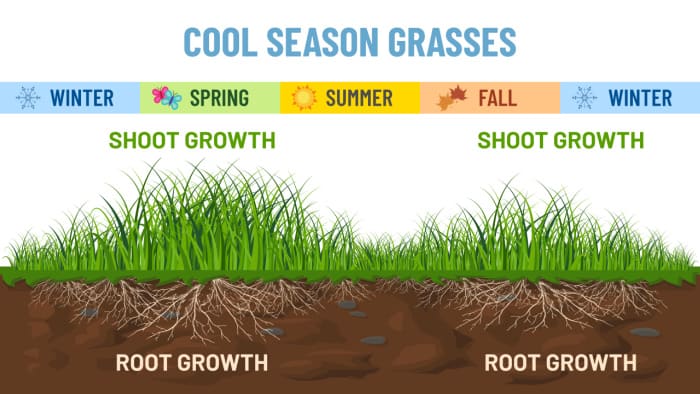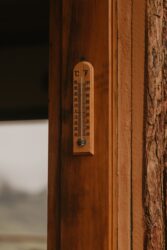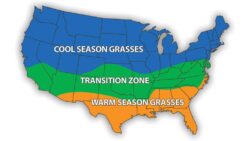Cool-season grasses are favored in climates where the weather doesn’t get overly hot, but what specific temperature ranges are ideal for these types of grasses?
Understanding this aspect is crucial for effective lawn maintenance and year-round greenery.
Ideal Temperature Range
Cool-season grasses thrive in temperatures between 60 and 75°F (16-24°C). This optimal temperature range allows them to undergo vigorous growth, especially during the spring and fall seasons.
Growth Seasons
The peak growth periods for cool-season grasses occur in the spring and fall, when temperatures tend to be milder.
It’s during these seasons that the grasses are at their healthiest and are most responsive to care such as fertilizing and over-seeding.
Here is a growth chart that shows a typical year of growth of a cool season grass type.

Source: Photo and great further reading from here
Effects of Frost and Cold
Contrary to what some might think, cool-season grasses are fairly resilient to frost and cold temperatures.
While growth slows down, these grasses generally do not go dormant until temperatures consistently stay below 50°F (10°C).
Summer Dormancy
During hot summer months, when temperatures rise above 85°F (29°C), cool-season grasses may enter a state of summer dormancy.
During this period, the grass will slow its growth and may even turn brown, but it usually recovers when temperatures drop.
Seasonal Variations
Different types of cool-season grasses may have slight variations in their temperature preferences.
For example, Kentucky Bluegrass prefers the lower end of the temperature range, while Tall Fescue can tolerate slightly warmer conditions.
Lawn Care Tips
During periods of extreme cold or heat, it’s advisable to reduce mowing and limit fertilization to prevent additional stress on the grass.
Watering needs will also fluctuate based on temperatures.
In Summary
- Cool-season grasses thrive in temperatures between 60 and 75°F (16-25 C)
- Peak growth occurs in the spring and fall.
- These grasses are resilient to frost and cold but may go dormant in high heat.
- Specific types may have slight variations in temperature preferences.
- Lawn care routines should adapt to extreme temperature conditions.



